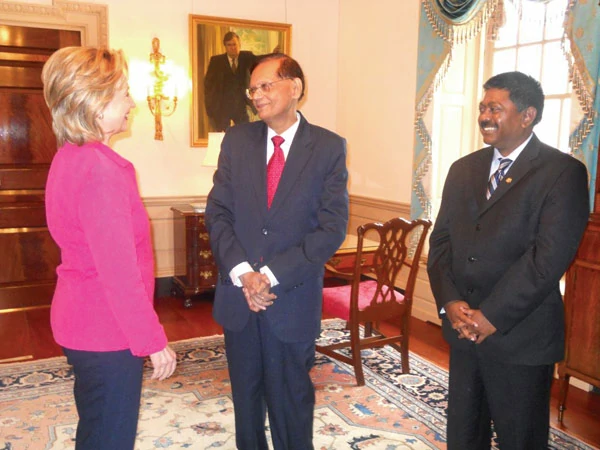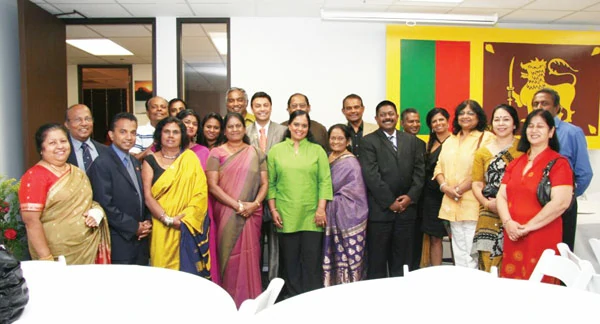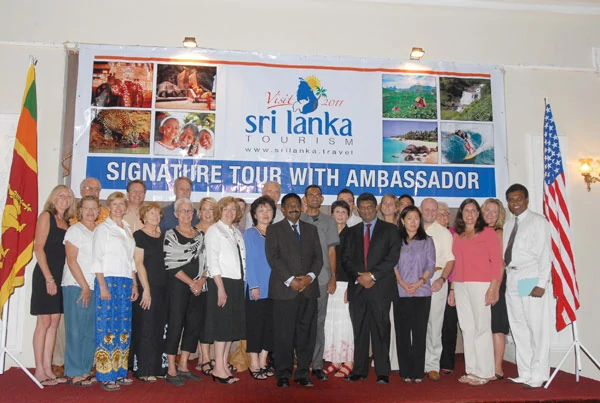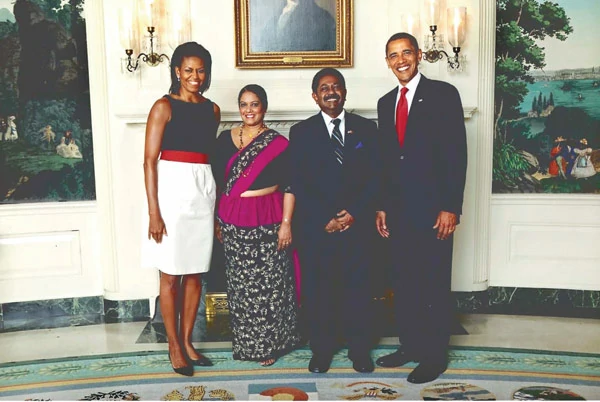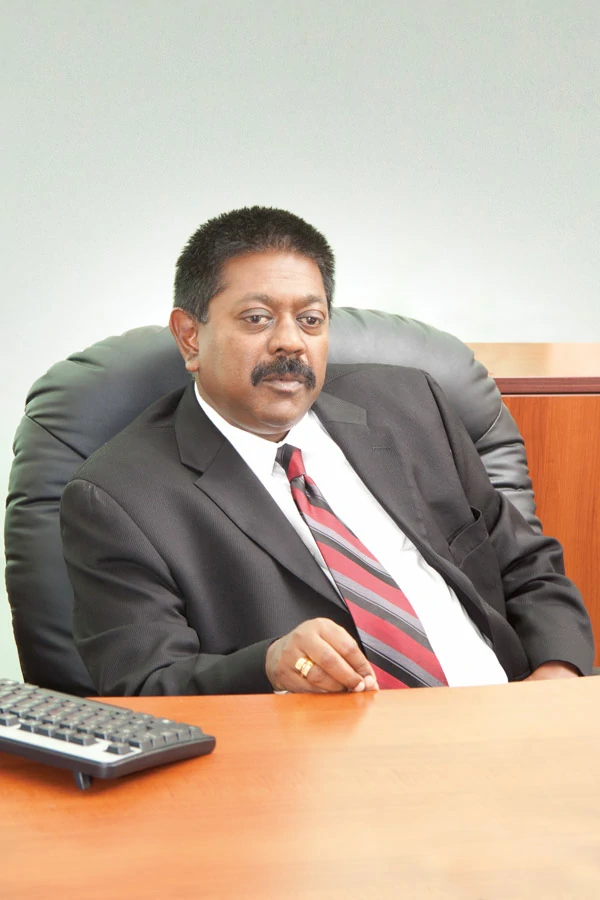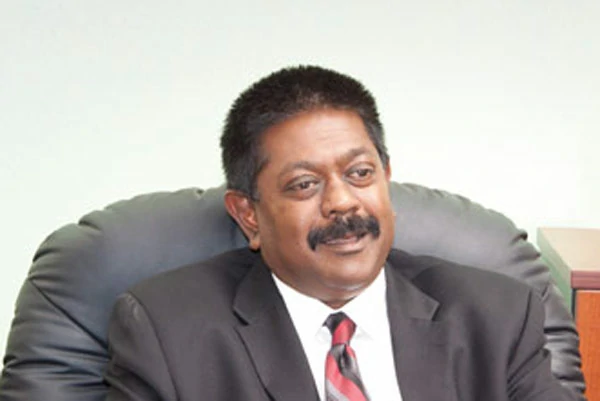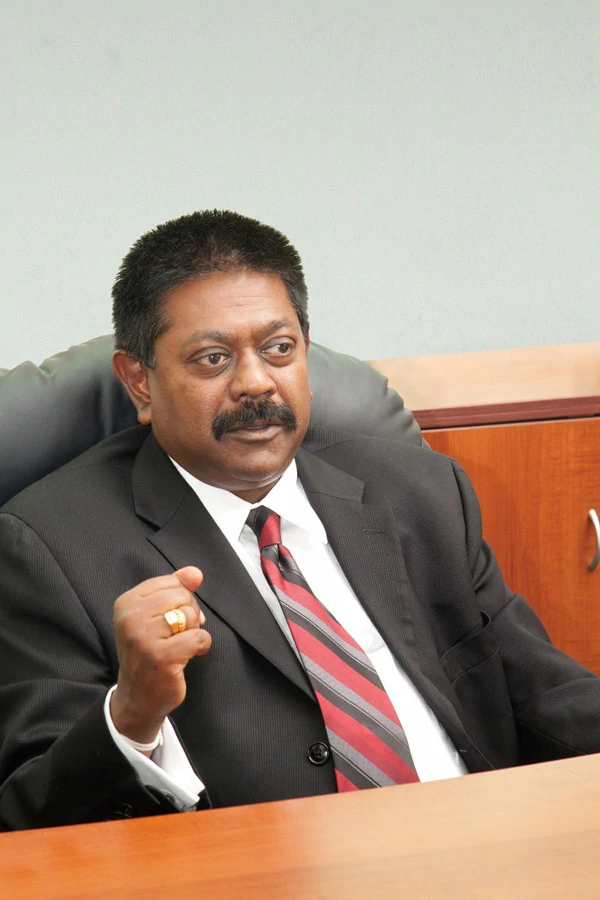
The relationship between Sri Lanka and the US spans hundreds of years. Trade relations between the two countries go back to 1787, when New England sailors first anchored in the harbours of Sri Lanka to engage in trade. Since then, the rapport between the two countries has only grown from strength to strength. Sri Lanka has been a friend as well as a democratic partner to the US while the US has assisted Sri Lanka in various fields including economic development, humanitarian assistance and military training. Recently, the US lifted the travel warning on Sri Lanka, and taking another step forward, the US government is promoting Sri Lanka by urging its investors to make
Sri Lanka their next business stop. Business Today spoke to the Sri Lankan Ambassador to the US, Jaliya Wickramasuriya about the current status of US-Sri Lanka relations, tourism and investor promotion in Sri Lanka as well as the Private-Public Partnership Conference scheduled to be held in Sri Lanka to explore the trade and investment opportunities in the emerging Wonder of Asia – Sri Lanka.
By Thilini Kahandawaarachchi
Photography by Mahesh Prasantha
What is the status of US-Sri Lanka relations at present?
Sri Lanka and the US have the best relationship at present. We have been working with the US for a long time, especially in the field of trade. Although we got independence from British rule 62 years ago, we have a history of trade relations with the US that spans beyond 200 years.
Two senior staff members Senator John Kerry and Senator Richard Lugar, who are the chairman and ranking member of the Senate Committee on foreign relations, came to Sri Lanka last year. I have been working closely with them for a long time and I was glad that they were able to come to Sri Lanka because then they could see the situation for themselves. I thought this would give them a more accurate picture of the current situation in Sri Lanka. The staff members Senators Lugar and Kerry had the opportunity to speak to a broad cross section of the community, including the secretary of defence, other senior government and opposition leaders, as well as with civil society. They travelled to many parts of the Island, including to the North and East.
Upon returning to the US, their report, “Re-charting US Strategy in Sri Lanka,” stated the importance of Sri Lanka to the USA, both in terms of location and otherwise. This report was a key turning point in the relationship between the US and Sri Lanka.
The second turning point in US-Sri Lanka relations was highlighting Sri Lanka as a tourism hotspot, particularly by New York Times. The Embassy of Sri Lanka in Washington DC and I worked extensively with the media. In January, The New York Times published an article that said Sri Lanka was the number one place to visit in 2010.
And it was not just The New York Times. National Geographic named Sri Lanka one of its 20 top places to visit in 2010. A luxury-lifestyle website, Dailycandy.com, also gave us a great write-up. It actually said, “There’s only one downside to Sri Lanka – eventually you have to leave.”
The third turning point was the visit of the newly appointed External Affairs Minister, Prof G L Peiris. We had been trying to get an appointment with the US Secretary of State Hillary Clinton. Though the US has always been supportive of us, it was difficult to schedule a meeting with the Secretary. In the last two years we have been informing and educating various US officers about the positive things we do in Sri Lanka, and by the time the new External Affairs Minister was appointed we were able to set up a meeting with Secretary Clinton. Assistant Secretary of State Ambassador Robert Blake and the US State Department were very positive in this effort. It was Prof Peiris’ first official international visit in the capacity of External Affairs Minister. The very fact that his first visit on his own as Minister was to the US sent out the message that Sri Lanka wanted to work closely with the US and that they are important to us.
“Sri Lanka is strategically located at the nexus of maritime trading routes connecting Europe and the Middle East to China and the rest of Asia. It is directly in the middle of the ‘‘Old World,’’ where an estimated half of the world’s container ships transit the Indian Ocean.”
Sri Lanka: Recharting US Strategy After The War By The Committee On Foreign Relations United States Senate, One Hundred Eleventh Congress, First Session On December 7, 2009.
When Secretary Clinton met Prof G L Peiris, she was very supportive of the Lessons Learnt and Reconciliation Commission. She stated that, “such commissions of inquiry have played an important role in advancing accountability and redressing wrongs in other countries emerging from periods of internal strife.” She also said that “experience in other countries has shown that such a commission that has the credibility and legitimacy within the country has a valuable role in advancing accountability” and that they are “very supportive of the approach taken by the Sri Lankans.”
During the discussions, with regard to resettlement of IDPs, we compared our resettlement plan with other countries. In Sri Lanka, resettlement was not after a disaster; It was after a war. There is a considerable difference between resettlement after a natural disaster and resettlement after a war. The international resettlement average in the world is over 17 years, according to the New York Commission on Women’s Rights. But we have resettled more than 90 percent within less than one year.
The Minister explained that “we have been able to resettle people in their natural habitat. But we have not been content with that. We want to ensure a restoration of livelihoods so that they are able to live their lives with dignity without bitterness or rancour.” The Secretary of State has contributed greatly to our ever improving and expanding relationship.
The US Defence establishments, including the Defence Department and FBI, have always been supportive, and in fact the US was the first country in the western world to ban the LTTE. That was a good example that set the trend and it helped us to get other countries as well to ban the LTTE. Thus, the US ban of the LTTE immensely helped us. The US not only banned the LTTE, but followed numerous measures against terrorism that included banning the TRO (Tamil Rehabilitation Organization) and Tamil Foundation, and bringing criminal cases against arms smugglers and money launderers.
We Have Received Letters From Tamils Who Have Returned To Sri Lanka From The US, Either To Visit For The First Time In Many Years, Or To Live. One Said That, “Now Everyone Lives Happily And We Can See That The Government And Military Are Doing Their Job.” Another Said, “Never In My Life Did I Think This Trip Would Be Possible.” I Think That Says It All.
As a government, we have exposed how global terrorism works. For instance, we have recovered so many weapons from the LTTE – a huge number of weapons which were bought and transported illegally from other countries. That shows how dangerous these terrorist networks are for all countries.
Of course, there are still a handful of people who are creating trouble in the US, but we continue to have a dialogue with government officials on the real situation; it is my responsibility to diplomatically handle these issues, which I am doing now.
You were the Sri Lankan Ambassador to the US at the height of the Humanitarian Operations. How did you tackle the various pressures put by the Diaspora, particularly when the world’s most ruthless terrorist organisation was using innocent civilians as a human shield?
I went to Washington DC from Los Angeles where I had had two years of diplomatic experience. Nevertheless, I had experience working with the international community and international businesses for over 25 years and that was of great value for me to better perform my functions. However, the main pressure on us was not from the Diaspora; but from various human rights activists and organisations that were not aware of the ground realities in Sri Lanka, such as Human Rights Watch, Amnesty International, Crisis Group. I met with many of these organisations and their representatives and gave them detailed explanations about what was actually taking place in Sri Lanka. I showed them how we were proceeding, sometimes even using images and other data that was provided to us by the government. Even during the last few days of the war, when Prabhakaran was cornered into a small area, I showed these groups the aerial maps and the footage and showed them how the LTTE was holding innocent civilians as a human shield. They could see for themselves how the LTTE would shoot civilians who were trying to cross over to the government held areas. I had to show them that we were doing things differently in Sri Lanka compared to other countries and that was why it was taking us time. On one hand, President Mahinda Rajapaksa had ordered the Armed Forces to maintain a zero civilian casualty level and on the other hand, there was the LTTE holding innocent people as human shields. It was an extremely difficult task, but our Service personnel did a great job and when I explained this to the various groups, they understood.
Now I hope that the human rights groups can acknowledge the positive changes in Sri Lanka. We are resettling displaced people. We are de-mining. We have not had terrorist violence against innocent civilians for more than a year. There have been no deaths due to terrorist violence. That is a lot of progress in one year. I would prefer to work with the human rights community. I hope they will accept our Lessons Learnt and Reconciliation Commission and note our progress, and find ways to support reconciliation and rehabilitation, which is happening at a rapid pace.
We have received letters from Tamils who have returned to Sri Lanka from the US, either to visit for the first time in many years, or to live. One said that, “now everyone lives happily and we can see that the government and the military are doing their job.” Another said, “never in my life did I think this trip would be possible.” Another wrote that, “now all my friends know about terror-free Sri Lanka.”
I think that says it all. President Mahinda Rajapaksa had a plan, and he carried it out and it has worked. We have our country back. People who never thought they’d be able to return have come back. We are all safe and we are moving forward. I think the world now is beginning to understand this more thoroughly. As an ambassador, it is my job to tell that story. We work on that every day in Washington.
On instances when I used to meet senators or congressmen, I would see members of the pro-LTTE Diaspora who had gone to brief the same people that I was to meet. Some senators and congressmen would show me pictures that these LTTE members had given them; some of these pictures were not even taken in Sri Lanka but scenes in other countries. In other instances they would show pictures of the massacres perpetrated by the LTTE as acts done by the government. As the Ambassador I did my duty, but sometimes they wanted members from the community to come forward. I gathered the anti LTTE/non-pro LTTE Diaspora to form groups and rallied their support and urged them to counter the various false allegations that the pro LTTE Diaspora were making.
Since the end of the war in May 2009, you have been engaging in meetings with the Diaspora to strengthen relations and to extend their support towards the post-conflict development of Sri Lanka. How have you engaged the Diaspora in the reconciliation efforts?
Involving the Diaspora in post conflict development and reconciliation is the main thing that we should do. Taking measures towards that was started even prior to the end of the war. Since May 2009 to May 2010 I have facilitated the visits of more than 100 Tamil Diaspora members who wanted to visit Sri Lanka. Their response has been amazing.
Some of them were extremely happy to have been able to see their families and relatives and sometimes the houses where they lived, which they said that they thought they would never get to see again. They were also thankful to President Mahinda Rajapaksa for making it possible. The Diaspora has offered to help in every possible manner to develop the country, particularly the North and East. We are in fact gathering their help to spread the message. Some of them even came back to Sri Lanka and settled back here.
President Mahinda Rajapaksa Had A Plan, And He Carried It Out And It Has Worked. We Have Our Country Back. People Who Never Thought They’d Be Able To Return Have Come Back. We Are All Safe And We Are Moving Forward. I Think The World Now Is Beginning To Understand This More Thoroughly.
I have also been carrying out outreach programmes that focused on the Sri Lankan Tamil community in the US, in places such as Chicago, Boston and Los Angeles. At times I had to meet them individually to listen to what they had to say, sometimes I met them in small groups. I am approachable at any time and they could call me on my mobile whenever they wanted. What I have come to realize is that those who propagate the LTTE are those who have not come to Sri Lanka to see what happens here and they are also the people who have had major monetary gains from the LTTE. Since they want this to continue, they do not want to see an end to the LTTE.
Sometimes mass e-mails are sent claiming to be from the Diaspora, but they are actually from set up centres where they have lists of names and e-mail addresses. The names and e-mail addresses purporting to be from the Sri Lankan community in the US are used to e-mail the Senate and the Congress and many other important organisations. But if you really check the IP addresses it is possible to find that they have all been sent from a few dozen computers around the country. I have been enlightening the people concerned about these measures and now they are aware of these practices. There is a small percentage of e-mails that are bona fide, but now they are mindful of these mass e-mails.
In the US, the Diaspora are educated people who are willing to assist Sri Lanka. For example, there is a doctor of physics who specialises in solar power. He has a patent on solar power equipment and he is also a supplier to the US government. He wants to set up solar energy related research centres in Jaffna, Ruhuna and Peradeniya and as a second step set up solar villages. I am using the assistance and the willing support extended by the Diaspora to develop Sri Lanka.
It has been more than two years since you were appointed as the Ambassador of Sri Lanka to the US. What do you consider are the most crucial achievements you have had since then?
Before I was appointed as the Ambassador in Washington DC, it was a different scenario; the war was going on, there was pressure from all sides and as representatives of the country we had to constantly update our host countries about how the Humanitarian Operations in Sri Lanka was different from the fighting in other countries. Once the war ended in May 2009, the state of affairs changed. To a certain percentage, now our work has been made comparatively easy.
In January The New York Times Published An Article That Said Sri Lanka Was The Number One Place To Visit In 2010.National Geographic Named Sri Lanka As One Of Its 20 Top Places To Visit In 2010. And A Luxury-Lifestyle Website, Dailycandy.Com Said, “There’s Only One Downside To Sri Lanka – Eventually You Have To Leave.”
I am glad that I was there during the most critical time. The pressure made me perform even better and I convinced over 70 congressmen and 40 senators, who did not even know about the situation in Sri Lanka. In the history of our diplomatic relations with the US since our independence, we would not have met that many senators and congressmen to brief them on Sri Lanka because it was not necessary in those days. Since I took over as Ambassador, we commenced an accelerated awareness-based campaign to inform not only the congressmen and senators, but also think tanks and officers at the State Department and Defence Department, World Bank, the IMF and many universities. I believe that I was successful in effectively communicating the correct and true story of Sri Lanka.
You have been actively promoting US investment in Sri Lanka. What measures have you been taking and who are the kind of investors that you have been in discussions with?
My approach is investor promotion, tourism and making people aware of the many good things about Sri Lanka and I continue to do that. Recently, the US Department of Commerce promoted investments in Sri Lanka by urging them to make Sri Lanka their next business stop.
We have an excellent relationship with the US Trade Representative for South Asia, Michael Delaney. He is a friend of Sri Lanka who believes that economic development can change many things. Sri Lanka needs economic development and the US can help us develop this economy.
Last year we had the Private Public Partnership conference, Trade & Investment Framework Agreement (TIFA) in Sri Lanka. The event attracted more than 40 companies to Sri Lanka, both from AMCHAM India and from the US. The event usually takes place in Sri Lanka every alternative year and in the US in other years. According to that this year it was scheduled to take place in the US, but Michael Delaney was convinced that this is the best time to bring investors to Sri Lanka and we have decided to hold the conference in Colombo from October 12 to 14, 2010.
This conference will be attended by about 25 investors from the US as well as additional US businesses currently operating in Singapore and India. I have already spoken to the Governor of Jaffna regarding showing these investors around Jaffna and its potential for investments. The ministers of economic development, external affairs and industries and commerce are all supporting this effort.
During the TIFA talks last year, we took the investors to Trincomalee. If we take them to Trincomalee again, they would be able to see the massive developments that have taken place in the area within this year. Last time when we went to Trincomalee, development was already happening. There are so many positive things. Within one year, bridges have replaced ferries and the roads have been carpeted, and much more. I can see similar or more development is happening in the Northern province as well.
There are many investors who I have spoken to already. One investor wants to commence a helicopter company, another investor wants to start a domestic air transport service with ten or twenty seater planes. Coca Cola has expressed their interest in setting up a juicing factory that will utilise tropical fruits grown in the country.
Caterpillar wants to set up a factory here and even Ford wants to start an assembly plant. Another company wants to start a retirement village. We have had discussions with the BOI and we need to work with them.
The BOI, the Trade Ministry and the Commerce ministry as well as Embassies are working with them and supporting them.
In addition to investors, we have been talking with American universities about establishing a study exchange programme with Sri Lankan universities. This would be such a great benefit to Sri Lanka, and to the students from the West who will be exposed to our country, people and culture. Yale University is quite interested. As you know, we spend a fair amount of foreign exchange on universities all over the world. By bringing study programmes or a branch of a foreign university to Sri Lanka, some of those funds stay in Sri Lanka.
What is your approach towards promoting tourism in Sri Lanka in the US?
I have noticed that if someone comes to Sri Lanka, no one will say bad things about Sri Lanka. They only have good things and positive things to say about our country. However, many US tourists do not come to Sri Lanka because we have not marketed Sri Lanka in this sector. I spoke to the management of the Tourist Board, and I am glad that the Minister of Economic Development, Basil Rajapaksa, is also the Minister of Tourism because he is very positive and supportive. If we work according to a proper plan, we can attract US tourists to Sri Lanka. Many people say that Sri Lanka is far away and that is why US tourists are not going to Sri Lanka. But they visit countries such as Maldives, Thailand and India. Therefore, you know that it is not about the distance. We have not marketed Sri Lanka properly.
Recently you invited an important US delegation to ‘A Signature Tour with the Ambassador’. What do you expect to achieve from this endeavour?
We started this programme called ‘A Signature Tour with the Ambassador’ about four months ago to create awareness about Sri Lanka. We invited not just tourists but also opinion makers and individuals with networks. I also hold meetings and gatherings both at the Embassy and at my official residence where I make presentations on tourism in Sri Lanka, our food, tea, culture and such features. I have been carrying out these programmes from the time I took up my appointment and since then I have been able to get about 600 people interested in coming to Sri Lanka.
25 prominent individuals such as doctors, professors, senior professionals as well as people with a lot of connections, travel writers and even a film location scout were part of the Signature Tour with the Ambassador. Everybody who came on this tour paid for their tour and the government did not spend any money on them. They travelled all over the country for ten days and we also had a media conference where the travellers spoke about their experience in Sri Lanka.
We Have Been So Fortunate To Have A Good Team Of American Diplomats To Work With, Both Here And In Washington. Ambassador Butenis And I Have Had A Good Dialogue From The Moment She Arrived Here. On Top Of That, We Are Fortunate To Have Robert Blake, Who Was The US Ambassador Here, As The Assistant Secretary Of State For South Asia. Ambassador Blake Understands Sri Lanka Deeply Enough To Know What The Real Situation Is.
Currently the US economy is still under the effect of the economic downturn. It is only those with a certain standing in society who are able to pay about 4,000-5,000 US dollars. We should provide them the infrastructure and adequate facilities. Such small gestures would go a long way in promoting tourism in Sri Lanka. I am sure the members of the Signature Tour will work as honorary ambassadors of tourism for Sri Lanka. I am doing whatever possible to promote tourism through the Embassy. If everybody gets together, I am confident that we can encourage US tourists to come to Sri Lanka.
In May 2010, the US State Department lifted the Sri Lanka travel warning. At present, how attractive is Sri Lanka as a destination to the US tourist?
We should thank the Minister of Economic Development for taking all the necessary steps. We should also thank Patricia Butenis, the US Ambassador to Sri Lanka, for her positive support in lifting the travel ban, as well the US State Department’s Office of American Citizens Services, which advises travellers. We also did our part by providing the necessary information to the State Department.
In fact I have to stop and say that we have been so fortunate to have a good team of American diplomats to work with, both here and in Washington. Ambassador Butenis and I have had a good dialogue from the moment she arrived here. On top of that, we are fortunate to have Robert Blake, who was the US Ambassador here, as the Assistant Secretary of State for South Asia. Ambassador Blake understands Sri Lanka deeply enough to know what the real situation is.
The New York Times article, lifting the travel warning and bringing a specialised group and getting the story out were three crucial points that changed the outlook on Sri Lanka and attracted US tourists to Sri Lanka. As an embassy we send newsletters, celebrate festivals and organise events such as food festivals and cultural shows at the embassy as well as at my official residence. We will continue to work very closely with the Tourism Development Authority to promote US travel to Sri Lanka. And we are promoting Sri Lanka as a film location. In fact, Bill Bowling, a well-known Hollywood location scout, took part in our Signature Tour. Sri Lanka has received a particularly noteworthy entry in the Location Guide, an annual review of possible film locations.
That is important because of the work being done to develop our film studios at Ranmihithenna in Hambantota. We really believe that Sri Lanka has a lot to offer the film industry because of our varied landscapes, climate and our state-of-the-art studios. And nearby are beaches and wildlife and rainforest.
Of course we also have to also kickstart the tourism process by continuing to promote the sorts of conferences and other events that we have had in the past. The investor conference we have held in Colombo last year and this year is a perfect example. People from the US come a long way, so they do not all just hurry back home when the conference is done. Many stay and explore Sri Lanka. For that reason, the more business conferences we can sponsor, the better. We also need to attract international sporting events, such as marathons, auto races and surfing contests. One example is World Cup Cricket taking place in February and March next year. This will not only bring visitors, but it will also show the world Sri Lanka in a positive light.
The US is a big market for some of our exports, particularly garments. At present what is the climate for Sri Lankan exports in the US?
Our main trade partner is the US and almost 50 percent of our garments are imported to the US. The US does not have the GSP+ but there is GSP, which applies to products other than garments. As you know, the US is a brand market with leading brands such as Victoria’s Secret, GAP, Banana Republic and Limited Brands. The good thing about brands is that people who want to buy a brand would anyway buy a brand and most of those companies have joint ventures with Sri Lankan companies. Therefore, they have to import from their company in Sri Lanka, which is a plus point for garments. Nevertheless, the market has decreased due to the economic conditions, not only for Sri Lanka but also other exporting countries are affected by the global economic downturn.
We are promoting other exports such as tea as well. Recently, the Minister of Plantation Industries had a discussion about ways to promote Ceylon tea in the US. In the US they have been used to Kenyan tea and Argentinean tea for a long time. But only a few are aware that Ceylon tea is the best in the world. When you get used to a certain taste even if you give pure Ceylon tea they do not think that it is good. The Minister of Plantations Industries, Mahinda Samarasinghe, and I have discussed a marketing and promotion campaign in the US to introduce more people to our high quality Ceylon tea. We are even considering Pure Ceylon Tea centres in different parts of the US to give US consumers the opportunity to taste our great beverage. In addition to the centres, we have discussed holding tea tasting events, forming Ceylon tea clubs and staging tea plantation tours. Since this is a natural drink and people will come to learn the health benefits of having tea, this is the time to promote it.
President Mahinda Rajapaksa And His Government As Well As Defence Secretary Gotabaya Rajapaksa And The Armed Forces Have Done Their Part. As Ambassadors, Now We Have To Do Our Part To Promote Sri Lanka More Aggressively. If We Do That And Continue Investor Promotion And Tourism Promotion I Am Sure We Can Achieve Our Goal Very Soon; That Is To Become The Wonder Of Asia.
Although the US is a price market, if customers know that Ceylon tea is the best, they will pay that price. With the economic downturn people have increasingly turned to dollar chains where commodities are cheaper than other retail stores. Argentinean tea is available at these stores and we should also make our teas available there. We should change the package quantity accordingly, without sacrificing quality and make them available in retail chains that are popular among people now.
What lies ahead for US-Sri Lankan relations?
We will have very positive years ahead. We should continue to work closely with the US. Even at present USAID is assisting us and we should use their assistance for development. We should enhance our relationship with the US and I can see that happening in the future. President Mahinda Rajapaksa and his government as well as Defence Secretary Gotabaya Rajapaksa and the Armed Forces have done their part.
As ambassadors, now we have to do our part to promote Sri Lanka more aggressively. If we do that and continue investor promotion and tourism promotion I am sure we can achieve our goal very soon; that is to become the Wonder of Asia.
